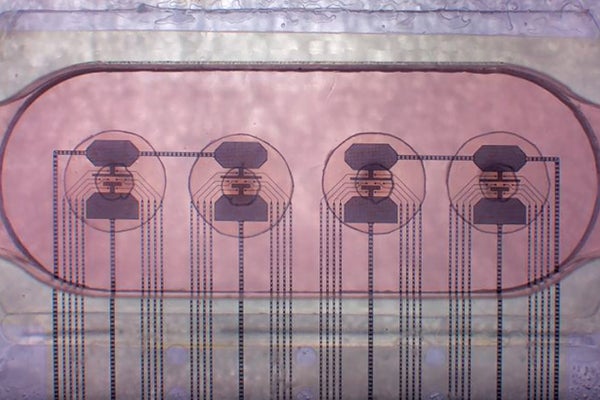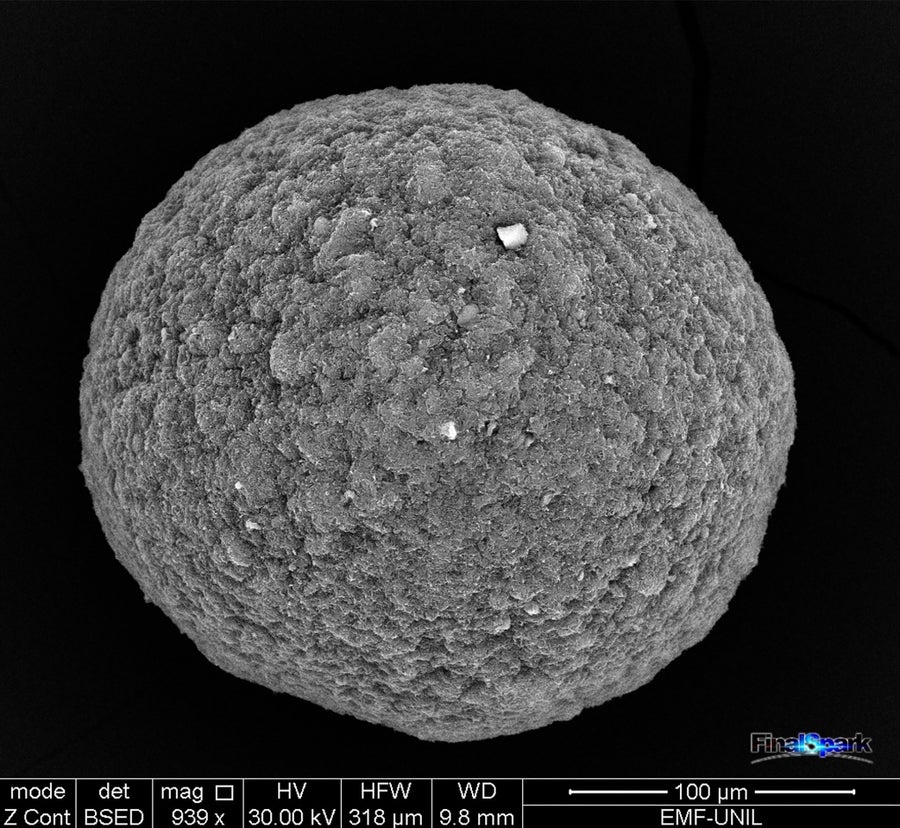These living computers are made from human neurons
In the quest for less energy-intensive artificial intelligence, some scientists are researching living computers.

Four clusters of live neurons are connected to electrodes on FinalSpark’s Neuroplatform chip.
Even artificial intelligence systems as advanced as ChatGPT rely on the same silicon-based hardware that has been the foundation of computing since the 1950s. But what if we could mold computers out of living biological material? Some researchers in academia and the commercial sector, wary of AI’s exponential growth in data storage and energy demands, have turned to a growing field called biocomputing. This approach uses synthetic biology, such as miniature clusters of lab-grown cells called organoids, to create computer architectures. Biocomputing pioneers include the company that earlier this year unveiled the “Neuroplatform,” a computer platform powered by human brain organoids that scientists can rent over the internet for $500 a month.
“To my knowledge, we’re the only people in the world doing this on a publicly rentable platform,” says FinalSpark co-founder Fred Jordan. Initially funded by the co-founders’ previous startup, FinalSpark is looking for environmentally sustainable ways to support AI. “Our main goal is to achieve artificial intelligence with 100,000 times less energy than it currently takes to train state-of-the-art generative AI,” Jordan says. Neuroplatform uses a series of processing units that each house four spherical brain organoids. Each half-millimeter-wide organoid is connected to eight electrodes that electrically stimulate neurons in the living space, and those electrodes link the organoids to a traditional computer network. The neurons are selectively exposed to the feel-good neurotransmitter dopamine to mimic the human brain’s natural reward system. These two settings — positive dopamine rewards and electrical stimulation — train the organoid’s neurons to form new pathways and connections in much the same way that living human brains learn. Once this training is perfected, FinalSpark says the organoids could eventually mimic silicon-based AI and act as processing units with capabilities similar to today’s central processing units (CPUs) and graphics processing units (GPUs).
For now, the organoids and their behavior are live-streamed 24 hours a day for researchers (and anyone else) to observe. “The challenge is figuring out the right way to get the neurons to do the thing we want them to do,” Jordan says.
Supporting science journalism
If you enjoyed this article, please support our award-winning journalism. Subscribe. By purchasing a subscription, you help ensure a future of influential stories about the discoveries and ideas shaping the world today.

One of FinalSpark’s neural organoids, made from 10,000 living neurons taken from human skin, is magnified approximately 1,000 times.
Research teams from 34 universities want to use FinalSpark’s biocomputer, and the company has granted access to scientists at the University of Michigan, Free University Berlin and seven other institutions so far. Each institution’s project focuses on a different aspect of biocomputing. The Michigan team, for example, is investigating the electrical and chemical stimuli needed to alter organoid activity, essentially creating the building blocks of an organoid-specific computer language, while scientists at Lancaster University in Leipzig, Germany, are trying to fit organoids into different models of AI learning.
Questions remain about whether organoid computing can compete with silicon at scale. For one, there’s no standardized manufacturing system. And living brains are mortal: FinalSpark’s organoids live only about 100 days on average (a significant improvement from the lifespan of the first experiments, which lasted just a few hours). But Jordan points out that Neuroplatform has “streamlined” its internal process for making organoids, and the company’s facility now houses between 2,000 and 3,000 of them.
FinalSpark isn’t the only company pursuing organic alternatives to silicon-based computing, nor are brain organoids the only possibility. “There are many different kinds of biocomputing,” says Ángel Goni Moreno, a researcher at the Spanish National Center for Biotechnology. Goni Moreno studies cellular computing, or the use of modified living cells to create systems that can reproduce “memory, logic gates and other decision-making fundamentals known from classical computer science.” His team is looking for tasks where biocomputers can perform better than silicon computers, a dynamic he calls “cellular supremacy.” In particular, Goni Moreno believes that cellular computers could react to environmental conditions and thus facilitate bioremediation, or the repair of damaged ecosystems. “This is an area where classical computers basically can’t do anything,” Goni Moreno says. “You can’t just throw a computer in a lake and have it tell you what the environment is like.” But a bacterial computer submerged in water could read subtle changes in environmental conditions as the cells respond to chemicals and other stimuli.
While Goni Moreno focuses on bacteria, Andrew Adamatsky of the University of the West of England International Journal of Non-Traditional Computing, is studying the computational capabilities of fungi. According to Adamatsky, hyphae, or networks of fungal threads, exhibit spike-like electrical potentials similar to those found in neurons. He hopes to harness these electrical properties to create a brain-like fungal computing system that “potentially can learn, reservoir computing, pattern recognition, and more.” Adamatsky’s team has already successfully trained a fungal network to enable the computer system to perform certain mathematical functions. “Fungal computing offers several advantages over brain organoid-based computing in terms of ethical simplicity, ease of cultivation, environmental tolerance, cost-effectiveness, and integration with existing technologies,” Adamatsky says.
Jordan is well aware of the considerations involved in using cultured human neurons for non-medical purposes. An ongoing bioethical debate concerns whether mini-brains could attain consciousness, but there is no evidence yet that any have been created in a lab. Jordan says he is currently seeking philosophers and researchers with the “cultural background to help answer these ethical questions.”
Despite his advocacy of fungal computing, Adamatsky acknowledges that brain organoids “may provide advanced functions due to their complex, neuron-like structure.” Jordan, meanwhile, is confident in Final Spark’s choice of biocomputer. “Of all the cells you could choose, human neurons are the best at learning,” he says.

